
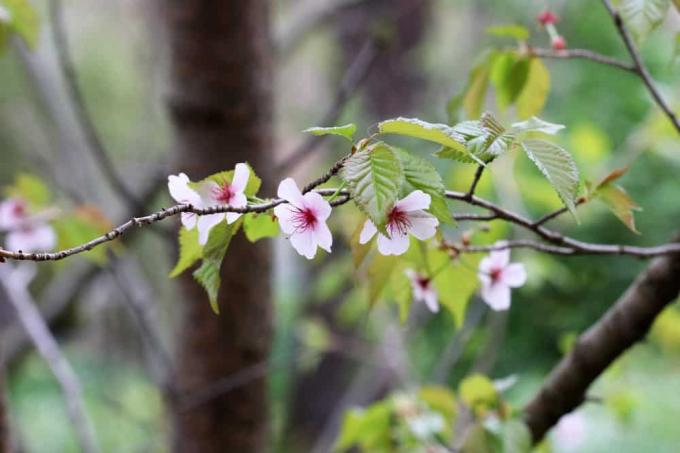
Table of contents
- growth and flowering
- Location
- Floor
- planting time
- plant out
- tub planting
- Fertilize
- Pour
- Cut
- propagation by cuttings
- diseases and pests
- hibernate
If you have a Kuril cherry, you will be provided with plenty of color and can forget the dreary winter time from March. Its numerous flowers are first pink then white. The foliage that follows develops a rich green, then shines strikingly orange-red in autumn. Thanks to its compact size, this ornamental cherry also fits in small front gardens. It is satisfied with little care and thrives almost incidentally.
growth and flowering
The Kuril cherry, bot. Prunus kurilensis is a small ornamental tree originally native to Asia. It grows up to about two meters high and just as wide. Thanks to the strong branching, this cherry species resembles a shrub. From April, the tree blooms with numerous white to violet flowers, from which small red cherries later develop. These are edible, but not particularly tasty for us humans. The birds, however, love these red fruits. Popular varieties are 'Brillant' and 'Ruby'.
Tip:
Due to its growth, the Kurile cherry is well suited for a Japanese garden.
Location
Prunus kurilensis has certain requirements with regard to the ideal location, although minor deviations from it are perfectly tolerated.
- requires a lot of heat and light
- it grows best in a sunny spot
- then plenty of flowers are formed
- it also thrives well in a partially shaded location
- in purely shady places it lacks warmth and light
Due to its size, the Kurile cherry is predestined for the middle row of plants. Larger trees can grow behind it, while low perennials come into their own in front of them. But even in a location where it stands as a solitary plant, this colorful wood cuts a fine figure.
Floor
The dwarf cherry does not like waterlogging. Heavy soil that does not allow water to seep well is not suitable for them. Fortunately, this can be easily loosened up with gravel or sand, so that it can still offer the cherry the optimal conditions.
- sandy, well-drained soil
- neutral pH
- well-loosened soil facilitates root growth
- enrich poor soil with some compost
planting time
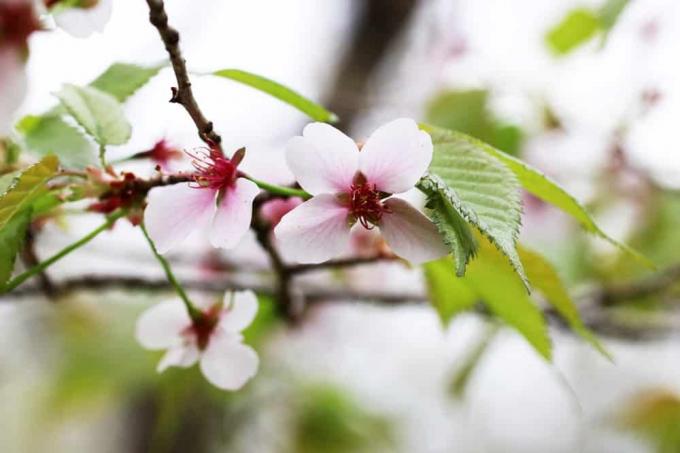
The leafless period from autumn is the ideal planting time for deciduous trees, including the Kuril cherry.
- plant between October and March
- Autumn and spring usually offer optimal temperatures
- in winter it can be too cold to plant
- Ground must be frost-free
This planting time should be strictly observed for bare-root trees. Kuril cherries, which are offered in containers all year round, can also be planted all year round. But here, too, the leafless period is best. At least hot and sunny days should be avoided if possible.
plant out
Planting a Kuril cherry in the garden is done as follows:
- Water the little sapling well by placing it in water for about 30 minutes.
- In the meantime, dig the planting hole. It should be at least twice the size of the root ball.
- Take the tree out of the container and place it in the prepared planting hole.
- Hold the Kuril cherry upright and fill in the gap with good potting soil.
- Tread the earth lightly.
- Pour the cherry well.
- Water the young ornamental tree regularly in the first year, as it will take time to root. Especially if the planting took place in a warm weather period, it is important to ensure sufficient water supply.
Tip:
Instead of potting soil, the excavated garden soil can also be used. Since the tree needs a lot of nutrients at the beginning, it should be enriched with compost or fertilizer beforehand.
tub planting
Since this beautiful tree remains relatively small even when fully grown, it is ideal for planting in large tubs. If necessary, the compact shape can also be kept smaller through targeted cutting measures. However, keeping them in a bucket requires a little more care:
- needs to be watered more often
- regular fertilizer application necessary
- repot after three years
- alternatively, rejuvenate the root ball
- possibly. provide a winter quarters
Tip:
In a pot, the Kurile cherry can be combined well with other smaller-growing flowers. On the one hand, this looks good, on the other hand, the root area is shaded and drying out is prevented.
Fertilize
Trees have an inherently good supply of nutrients. If they are given too much artificial fertilizer, they can quickly become unbalanced.
- Compost when planting
- otherwise fertilize very sparingly
- A little phosphorus fertilizer before flowering promotes flowering
Pour
The watering of the Kurile cherry depends on the weather and is based on the actual water requirement.
- > watering required on warm and dry days
- > Water when the top layer of soil is dry
- > Young trees and potted plants need to be watered more often
A notice:
This dwarf cherry also tolerates calcareous irrigation water.
Cut
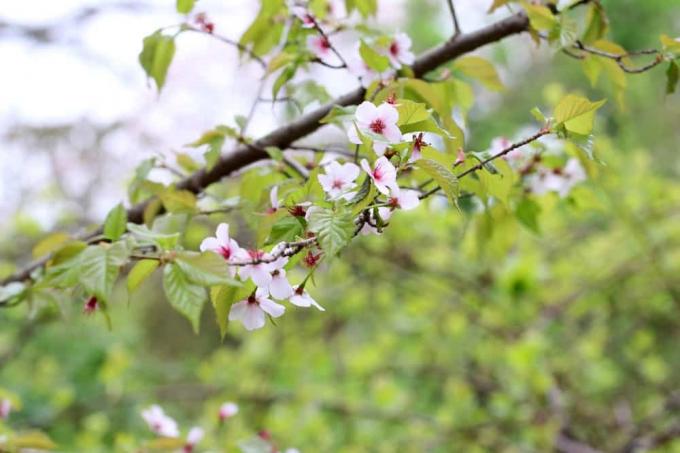
Kurile cherry grows very slowly and branches very nicely. A cut is not necessary, but can be done if necessary.
- only cut after the third year of growth
- Spring before new shoots is ideal is ideal
- Thin out solitary plants only carefully
- Shorten branches that are too long after flowering
propagation by cuttings
In principle, the dwarf cherry can be propagated by cuttings. However, this method requires a lot of luck. Laypersons rarely succeed in this type of propagation and is therefore not recommended. If you still want to try it, you should note the following:
- Autumn is the right time
- Use sand substrate
- Choose shoots with at least two eyes
- Put the pot with the cutting in the shade
- keep moist all the time
If the cutting is successfully rooted, it can be planted outside in the spring.
diseases and pests
A well-groomed Kuril cherry is safe from pests. From time to time the Prunus can be attacked by the Monilla fungus. The fruits rot and show brownish spots. The usual cutting measures bring no improvement here. The fungal disease can only be fought permanently with fungicides.
hibernate
Prunus kurilensis copes well with the winter cold. It survives down to -35 degrees without damage.
- no special protective measures required outdoors
- Container plants should overwinter in a cold but frost-free room
- Alternatively: wrap the pot with protective fleece
A notice:
Potted plants do not tolerate strong sunlight in the winter period. They should therefore be placed in the shade.
 garden editorial
garden editorial I write about everything that interests me in my garden.
Learn more about fruit trees
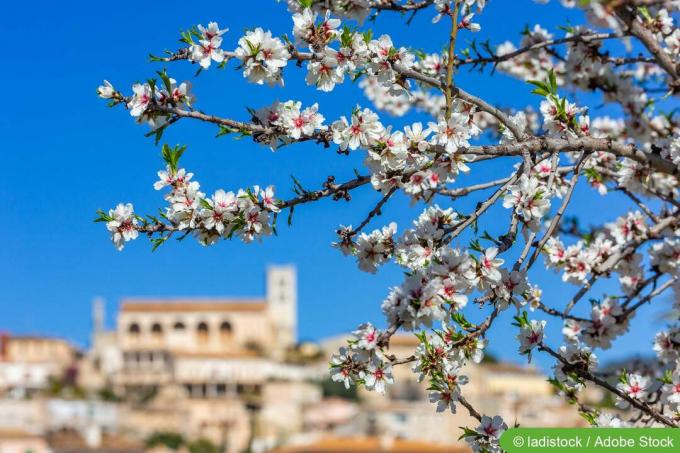
Life on Mallorca: highlight almond blossom
Life on Mallorca offers a lot more than sun, summer, beach and Ballermann. The beginning of the year on the popular holiday island is all about blossoming almond trees. We'll tell you when and where you can best enjoy the almond blossom on Mallorca.

Cutting sour cherries: 21 tips for the right cut
In order for a sour cherry to remain productive year after year, it must be pruned regularly. Wood that has been removed must be removed and new fruit wood must be promoted. This only works if the "editor" knows the editing rules.

Is the ornamental peach edible? | 15 tips for care and cutting
The ornamental peach can be a decorative addition to the garden as early as March, when the trees, which are up to three meters high, are in bloom. Here we tell you how to look after them and whether their fruits are edible.

20 old apple varieties | List of old apples in & around Germany
Hardly any type of fruit is as diverse as the apple. The number of apple varieties worldwide is estimated at over 20,000. Old apple varieties are those that were discovered before 1950. We have compiled a list of popular, old varieties for you.
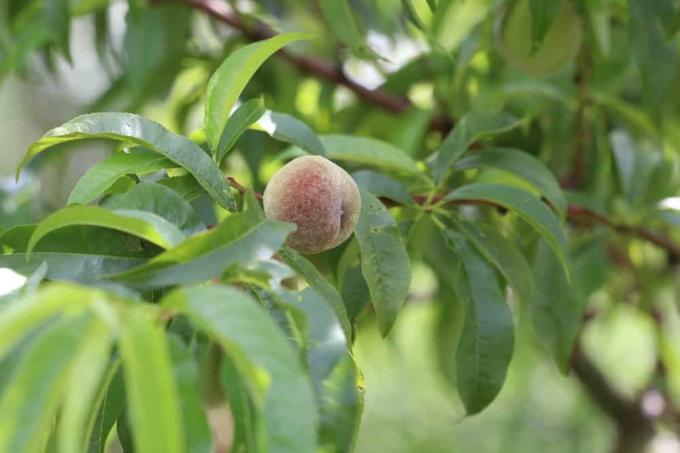
Peach Tree Diseases: Leaves curl or turn yellow
Among the fruit trees, the peach tree is one of the most susceptible to diseases. It often has to contend with fungal diseases such as curling disease. Here you can find out which other tree diseases can affect it, how to recognize them and how to fight them successfully.

Half-trunk cherry and apple trees: planting distance and care
Fruit trees definitely belong in every garden. But what to do if the garden is too small for a large tree? Then trees that were grown as half-stems can help. They take up less space, but deliver lots of fruit. More about this here.



